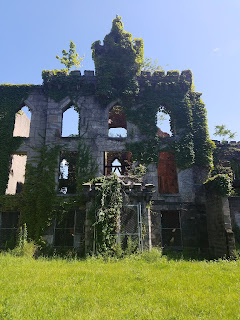My spouse and I took the aerial tram to visit Roosevelt
Island on a Thursday afternoon in late August 2018. Two-mile long, 800-foot
wide, 147-acre Roosevelt Island is located in the middle of New York’s East
River, offering great views of the east side of Manhattan (including the United
Nations and Chrysler Building) as well as of Queens on Long Island. We spent
about two hours there; although the island is walkable, it is equivalent to
about 35 city blocks long, so we rode the red RIOC free public bus as far as we
could in each direction, then walked the rest of the way to each tip. Previous
famous residents include actress Sarah Jessica Parker and former UN
Secretary-General Kofi Annan. The island offers an elementary school, playgrounds
and playing fields, library, apartments/condos/co-ops, churches, medical
services (doctors, dentist, rehab hospital/nursing home), technology campus
incubator, markets, shops, restaurants, parks, waterfront promenades, and
historic buildings.
Roosevelt Island was originally called Minnehanonck by its
first residents, the Lenape Indians. Later, the Dutch called it Hog Island. It
has also been known as Blackwell Island, named after the British colonist whose
house still survives today and for whom the lighthouse is named. The city of
New York bought the island in 1828, at which time it was called Welfare Island
because it housed a state penitentiary (later moved to Riker’s Island), Charity/City/Island
Hospital (no longer standing, but whose stones were used to create the Four
Freedoms Park on the south end of the island), and a lunatic asylum (the
entrance to which was the Octagon Tower, still in use today as the entry to a
luxury apartment building). The island was renamed Roosevelt Island in 1971, in
honor of Franklin Delano Roosevelt.
At the northern end of the island is the Gothic-style Blackwell
Island Lighthouse; built in 1872 and used until the 1940s, it was designed by
the same architect who created St. Patrick’s Cathedral. (Note that you cannot
enter/climb the 50-foot high lighthouse.) On the southern end of the island is the
Franklin
D. Roosevelt Four Freedoms Park. Open
daily except Tuesdays, this park offers semi-permanent restroom facilities and
a small kiosk where you can buy water, ice cream, and small souvenirs. The
expansive park has multiple levels, some tree-lined areas, a large stone/marble
monument to Roosevelt, and the historic remains of the Renwick Smallpox Hospital.
First built in 1856 to quarantine infected immigrants who had not been immunized
against the disease, the Gothic Revival style structure functioned as a nursing
school from 1875 until the 1950s. Afterwards, the building fell into disrepair
and ruins, but in 1972, the hospital was added to the National Register of
Historic Places, and funds are currently being razed to stabilize the building
so that someday visitors can enter.
The highlight for many visitors is riding the 4-minute Roosevelt
Island Aerial Tramway, which first opened in 1976. Each of the two cars holds
up to 110 passengers at a time (mostly standing), and they cross back and forth
more than 100+ times per day. The tram ride costs $2.25 each way or $4.00 round
trip, and you can use your MetroCard. (If you don’t have a card, you can
purchase tickets from a machine that accepts cash as well as credit cards.) The
tram has been featured in many movies and TV shows, including Spider-Man (Tobey Maguire and Kirsten Dunst) and Now You See Me (Isla
Fisher, Jesse Eigenberg, Mark Ruffalo, Woody Harrelson, and Morgan Freeman). Because
the tram does not run 24 hours per day, you can also reach Roosevelt Island by
subway, bus, or car.
We enjoyed our visit to Roosevelt Island; it and the aerial
tramway have been on our “to see” list for a long time.















































No comments:
Post a Comment